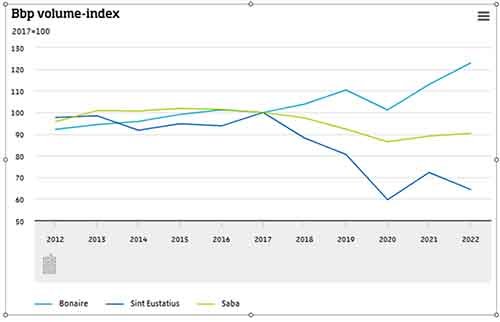Bonaire’s economy grew by 8.8% and Saba’s by 1.5% in 2022, while St. Eustatius saw an eleven percent decline, driven by losses in major companies tied to the international oil market. These figures were reported by the Dutch Central Bureau of Statistics (CBS) on Thursday.
Bonaire’s growth was driven by the accommodation, recreation, and food services sectors, while St. Eustatius’ decline was mainly due to the shrinking turnover of a limited number of large businesses.
The biggest contributor to Saba’s modest growth was down to the government opening up 7% more jobs in the civil service, CBS said.

Saba
The number of tourists arriving in Saba increased to approximately 4,900 in 2022, up from 4,000 recorded the year before. However, this is still considerably lower than in 2019, when about 8,800 tourists visited the island.
“Although more tourists visited the island, the value added to the sector declined, as well as in the education sector, because there were fewer [medical — Ed.] students,” CBS said.
Public administration made the largest contribution to Saba’s economic growth in 2022, with 7% more jobs being added to the sector.
Bonaire
Bonaire lifted its corona-virus restrictions at the beginning of 2022, which saw tourist arrivals by air exceeding pre-pandemic figures, increasing to 173,000 that year compared to 111,000 arrivals in 2021 and 158,000 in 2019.
“This led to an increase in the value added of both the accommodation and food services and recreation sectors by over 45%,” CBS said.
Supermarkets performed particularly well in 2022, CBS said, with the island’s population increasing by 5.3% that year.
The real estate industry also recorded 17.5% growth, “as many building lots were sold”, CBS said.
Public administration increased by 17.1%, with the number of jobs in this sector reaching 1,490 in 2022, compared to 1,270 in 2021.
Despite the overall economic growth in 2022, the construction industry recorded a decline of 6.9% and the number of jobs fell by 4%. This is in stark contrast to recent trends, as the construction industry in Bonaire has grown by more than 50% since 2017.
There was also a 6.5% decline in the transportation, information and communications industries, while financial services fell by 9.6%.
St. Eustatius
St. Eustatius’ economic decline in 2022 was attributed to “a few large businesses on the island”, which are “mainly export-oriented and dependent on oil demand in the region,” according to CBS.
“Demand for these businesses’ products and services fell in 2022,” CBS said. “Although these businesses substantially impact St. Eustatius’ [gross domestic product] GDP, their impact on national income is limited. The profits of these businesses are not included in the national income because they are wholly foreign-owned enterprises.”
Compared to 2017, CBS said St. Eustatius’ GDP fell by 35% in 2022, or from US $142 million to $92 million.
“This was due to several factors. In 2017, Hurricane Irma caused major damage on the island. In 2019, several large businesses were greatly hampered by regional developments in the oil sector, which reduced demand for oil storage. On top of that, the COVID-19 pandemic struck in 2020, reducing the demand for oil storage even further and decreasing the number of tourists,” CBS said.
St. Eustatius’ economy had not returned to pre-pandemic levels in 2021, only recording slight growth in hard-hit sectors, such as accommodation, food services and transportation. “And in 2022, the economy shrank due to a further decline in foreign demand for the products and services of some of the island’s large businesses,” CBS said. `Although the number of tourists increased by more than 50% to 5,600, the additional demand created by this in the accommodation and food services sectors, in particular, was insufficient to compensate for the contraction of large businesses.”
The Daily Herald.

 Saba News News and Information from Saba Island, Dutch Caribbean
Saba News News and Information from Saba Island, Dutch Caribbean
